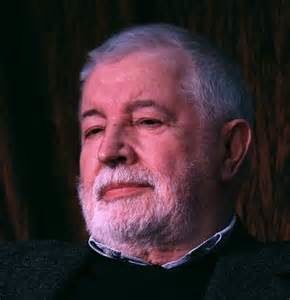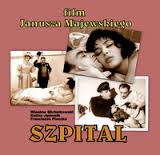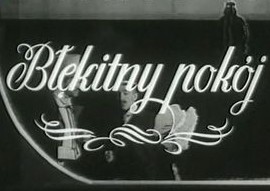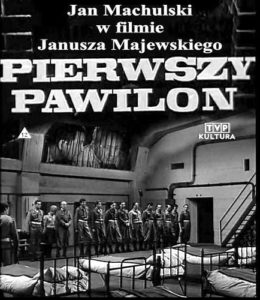 Janusz Majewski is one of Poland’s most durable and prolific filmmakers. In a career that spans half a century Majewski has directed a variety of films, with comedies and period pieces predominating. He also made LOKIS, one of Poland’s most famous horror features, and a wealth of horror-themed shorts that comprise a significant body of work in their own right. In fact, I’d argue that Majewski can be counted as the foremost director of Polish horror movies (his only real competition in this regard are his fellow countrymen Roman Polanski, Jerzy Skolimowski and Andrzej Zulawski, all of whom have made the majority of their films outside Poland).
Janusz Majewski is one of Poland’s most durable and prolific filmmakers. In a career that spans half a century Majewski has directed a variety of films, with comedies and period pieces predominating. He also made LOKIS, one of Poland’s most famous horror features, and a wealth of horror-themed shorts that comprise a significant body of work in their own right. In fact, I’d argue that Majewski can be counted as the foremost director of Polish horror movies (his only real competition in this regard are his fellow countrymen Roman Polanski, Jerzy Skolimowski and Andrzej Zulawski, all of whom have made the majority of their films outside Poland).
Majewski’s affinity for the scary stuff was evident in his earliest work, such as the 1958 student short RONDO (ROUNDABOUT). It features a man in a restaurant trying to get the attention of a distracted waiter made up to resemble Charlie Chaplin (or perhaps Adolph Hitler?). This entails playing a violin and firing a gun, but all those things accomplish is scaring away the waiter, forcing the protagonist to chase him through the wilderness. Eventually they make it back to the restaurant, but things don’t go any better there, and result in a bloody confrontation.
A visually impressive work, but also an amateurish one with a rather wobbly and distracting sense of surrealism.
1960’s MOST (BRIDGE) provided the first instance of Majewski’s evident passion for horror literature. It’s an adaptation of Ambrose Bierce’s Civil War-set classic “An Occurrence at Owl Creek Bridge” that Majewski completed a full two years before Robert Enrico’s better known filming of the same story.
The two films, I might add, are quite close in tone and style, seeing as how both were lensed in highly atmospheric black-and-white and set in extremely craggy, rocky landscapes where the protagonist, a condemned man about to be hung off a bridge, manages to escape his sentence–or so it seems!
Majewski adds much of his own to the 13-minute MOST, including a lengthy flashback in which the protagonist learns of his death sentence and highly impressionistic sound design–which does admittedly foreshadow the shock ending, but I’m sure you all know what happens anyway.
1962’s SZPITAL (HOSPITAL) is set entirely in a claustrophobic hospital room where a male patient is confined. Throughout the film the room is invaded by a  variety of strange people who at times even appear in bed with the guy. Another peculiarity is the ever-present sound of a train whistle, an apparent Holocaust reference that carries over into the increasingly macabre final scenes, wherein the man is accosted by a indistinct figure and a gun-wielding beaurocrat.
variety of strange people who at times even appear in bed with the guy. Another peculiarity is the ever-present sound of a train whistle, an apparent Holocaust reference that carries over into the increasingly macabre final scenes, wherein the man is accosted by a indistinct figure and a gun-wielding beaurocrat.
A definite improvement on the similarly surreal RONDO, with a more robust visual style and profoundly troubling political implications.
In 1964’s hour long AWATAR (AVATAR) Majewski again adapted a famous text, this one an 1856 novella by Theophile Gautier. The film has a light, rather comedic tone that shows Majewski was fully aware of the ridiculousness of Gautier’s premise, involving a lovesick bachelor and a married count who by the machinations of a supernaturally endowed physician are made to switch bodies–and discover that life in someone else’s skin isn’t much fun at all.
The scene in which the switch occurs, with animated balls and squares representing the respective life essences, is representative of the film’s whimsical bent. The jaunty tone, however, doesn’t suit the material, which despite its outrageousness is best played straight.
 The 29-minute BLEKITNY POKOJ (THE BLUE ROOM), from 1965, was based on a quasi-horror story from 1866 by Prosper Merimee, who would provide the source material for two subsequent Majewski shorts. It’s about a vacationing couple who meet an eccentric Englishman on a train; arriving at their hotel the couple, to their understandable annoyance, find the Englishman checking into the room next to theirs.
The 29-minute BLEKITNY POKOJ (THE BLUE ROOM), from 1965, was based on a quasi-horror story from 1866 by Prosper Merimee, who would provide the source material for two subsequent Majewski shorts. It’s about a vacationing couple who meet an eccentric Englishman on a train; arriving at their hotel the couple, to their understandable annoyance, find the Englishman checking into the room next to theirs.
The horror begins later that night, when following a loud crash in the Englishman’s room what looks like blood is seen trickling under the door. Not wanting to be involved in a murder the couple resolve to cut short their vacation, but an ironic final twist throws the events of the night into an entirely different light.
A mildly entertaining trifle.
1968’s 28-minute DOCENT H. (ASSOCIATE PROFESSOR H.) is more science fiction than horror, but nonetheless contains its share of shivery elements. The title character is a professor looking to replace humans with cyborgs. His supremely creepy assistant Traumer, strikingly played by Majewski regular Andrzej Rausz, is one such creation. Professor H. intends to transpose Traumer’s brain with that of a renowned scientist, but is in for a surprise.
A dark film in every sense, DOCENT H. is particularly noteworthy for its soundtrack, consisting of eerie whirs and beeps interspaced with snatches of Bach’s immortal “Toccata and Fugue in D Minor.”
Incidentally, this film is said to have inspired the “robotic image” of the pioneering electronic music outfit Kraftwerk (as is evident in Kraftwerk’s “The Robots” video, which can be found on YouTube).
PIERWSZY PAWILION (FIRST PAVILION), also from 1968, is similarly heavy on the science fiction, with a renowned college professor lured from his home one night by the promise of a scientific breakthrough. He winds up in the factory of a mad scientist who has a stable of people he’s shrunk down to thimble size. The shrinking occurs in a claustrophobic shower that emits radiation in place of water (a holocaust reference?), a contraption in which the hapless professor is eventually enclosed.
night by the promise of a scientific breakthrough. He winds up in the factory of a mad scientist who has a stable of people he’s shrunk down to thimble size. The shrinking occurs in a claustrophobic shower that emits radiation in place of water (a holocaust reference?), a contraption in which the hapless professor is eventually enclosed.
The film is interesting for Majewski’s use of primitive (by Hollywood standards) special effects and high angle shots that render ordinary sized people diminutive, but otherwise it’s pretty silly.
In 1969’s WENUS Z ILLE (VENUS D’ILLE) Majewski returned to the work of Prosper Merimee, specifically his 1835 story “Venus d’Ille,” about an accursed statue (a story that was subsequently filmed by Mario and Lamberto Bava in 1979). Said statue, fashioned in the guise of an anguished woman, is seen in a remote inn, having been recently interred from the ground. The occasion is a wedding attended by the protagonist, an unassuming man who becomes caught up in a bizarre nightmare when the groom unthinkingly sticks his wedding ring on a finger of the statue–and can’t get it off!
This naturally results in much horror and unpleasantness, all of it, frustratingly enough, talked about rather than shown. Beyond that this 26-minute effort is reasonably chilling, but never quite rises above the level of an average TWILIGHT ZONE episode.
 On to 1970’s aforementioned LOKIS. REKOPIS PROFESORA WITTEMBACHA (LOKIS: THE MAUSCRIPT OF PROFESSOR WITTEMBACHA). Based once again on a tale by Prosper Merimee, it concerns a young aristocrat who’s a were-bear. Of course it takes the protagonist, a scholarly minister staying at the bear-man’s country mansion, the entire movie to figure this out. In common with the Merimee story the accent is on atmosphere rather than incident, with an overpowering sense of brooding mystery that builds to a deeply chilling climax. The film is very old school, in short, which is a large part of its charm.
On to 1970’s aforementioned LOKIS. REKOPIS PROFESORA WITTEMBACHA (LOKIS: THE MAUSCRIPT OF PROFESSOR WITTEMBACHA). Based once again on a tale by Prosper Merimee, it concerns a young aristocrat who’s a were-bear. Of course it takes the protagonist, a scholarly minister staying at the bear-man’s country mansion, the entire movie to figure this out. In common with the Merimee story the accent is on atmosphere rather than incident, with an overpowering sense of brooding mystery that builds to a deeply chilling climax. The film is very old school, in short, which is a large part of its charm.
It also boasts a bold and confident visual style, and some mighty striking scenery; LOKIS was Majewski’s first-ever color film, and he definitely makes the most of the format.
The 26 minute OKNO ZABITE DESKAMI (THE BOARDED WINDOW) from 1971 was Majewski’s second color production. Its basis was the 1891 Ambrose Bierce story about a man and woman residing in a dense forest whose lives undergo a most unsettling upheaval.
Majewski updated the story to modern times, opening with a helicopter delivering the protagonists’ mail. They live a peaceful life in a rustic cabin, until one night the woman falls sick and dies–or so it seems.
This film has a brooding ambiance that sets it apart from many of its fellows (no goofy whimsy is evident here), and some real shocks in the second half. Furthermore, the bold color cinematography foreshadows the garish visuals of SYSTEM, Majewski’s finest achievement in the genre.
It was back to black and white for the 26 minute MARKHEIM (1971), one of Majewski’s most effective shorts. Based on an 1884 story by Robert Louis Stevenson, it pivots on a strong performance by Jerzy Kamas, playing a heel named Markheim who impulsively kills an elderly antique dealer during an attempted robbery. From there Markheim’s sense of reality steadily dissolves in a morass of guilt and shame, until a spectral dog leads him to a shadowy figure who seems to know an awful lot about Markheim and his problems–a fact that, once the figure’s identity is finally revealed, makes a lot of sense.
it pivots on a strong performance by Jerzy Kamas, playing a heel named Markheim who impulsively kills an elderly antique dealer during an attempted robbery. From there Markheim’s sense of reality steadily dissolves in a morass of guilt and shame, until a spectral dog leads him to a shadowy figure who seems to know an awful lot about Markheim and his problems–a fact that, once the figure’s identity is finally revealed, makes a lot of sense.
Majewski does a fine job adapting Stevenson’s story, excising much of the climactic dialogue between Markheim and the shadowy figure that in my view marred the text, and pulls off some terrifically shadowy, noirish visuals. In this respect the black and white photography definitely works to MARKHEIM’S benefit (it’s been rumored the film was shot in color, but the only available prints are B&W).
The final film on our list is SYSTEM from 1972, the arguable apotheosis of Majewski’s work in the horror field. It’s an alternately restrained and outrageous adaptation of Edgar Allen Poe’s “The System of Dr. Tarr and Professor Fether” that like OKNO ZABITE DESKAMI before it was updated to the modern world.
It features a young man and a lady friend driving to an insane asylum whose overseers the woman knows. Weirdness is evident before they even reach the place, in the form of a ranting maniac in a tree. More crazies are found freely wandering the grounds of the asylum, they being participants in an apparently revolutionary new system instituted by the asylum’s director. But the director seems just as nutty in his own way as the patients, and it turns out there’s a good reason for this: he is one of the patients, having taken over the asylum and locked up its overseers.
With this film, running an economical 27 minutes, Majewski follows the particulars of Poe’s tale while making his own subtle and appropriate additions, most of them perversely sexual in nature (the protagonist is nearly ravished at one point by a voluptuous nymphomaniac). The overall atmosphere of unfettered insanity recalls that of MANSION OF MADNESS, Juan Lopez Moctezuma’s more expansive 1971 adaptation of the same story, but Majewski’s is a more focused and controlled work, doing justice to both Poe’s vision and his own.
Now in his eighties, it’s highly unlikely that Janusz Majewski will make any more horror films–or, frankly, any more films period (his last directing credit was in 2010). Yet I’d say MOST, LOKIS, OKNO ZABITE DESKAMI, MARKHEIM and SYSTEM are achievement enough, and more than solidify Majewski’s place in the horror lexicon. If you haven’t seen them that’s something you simply must remedy ASAP!
